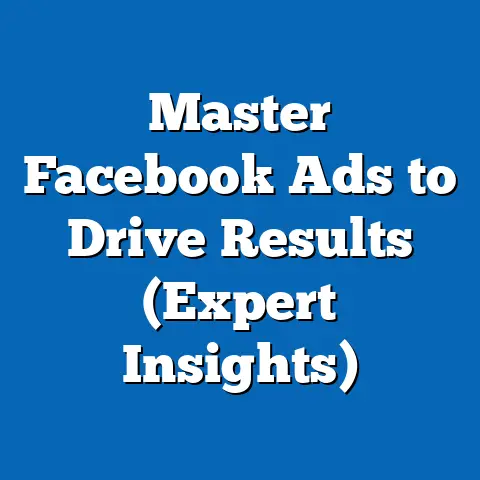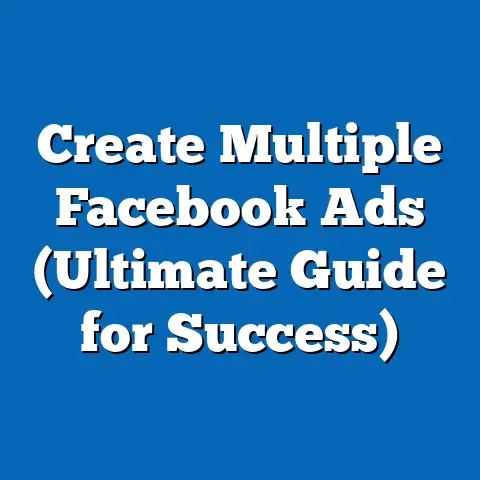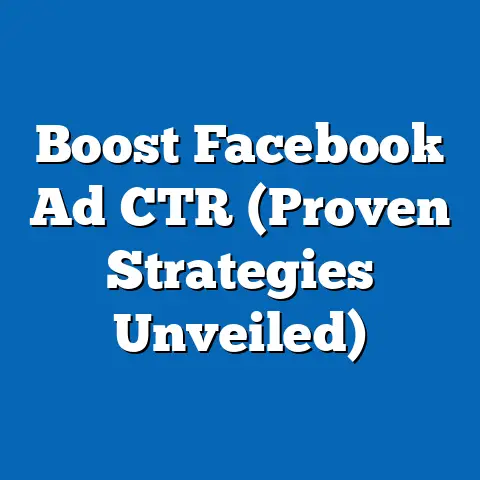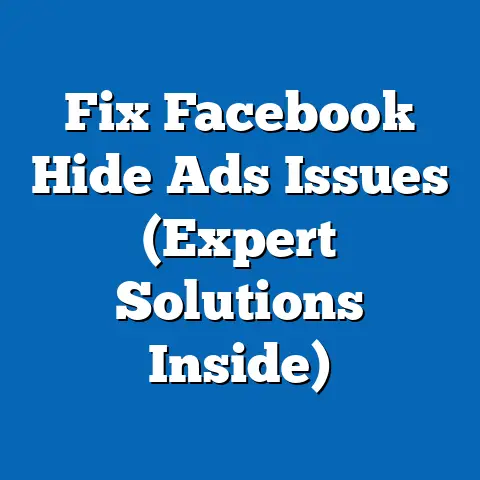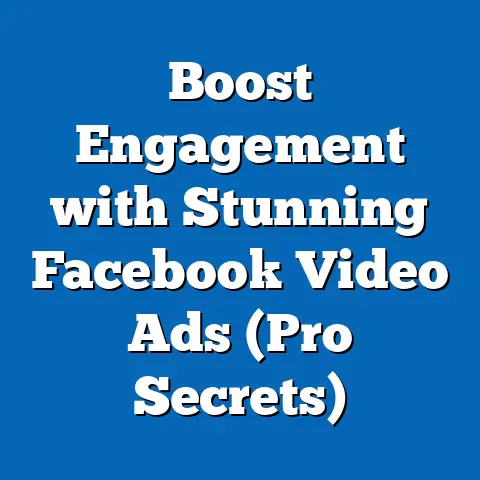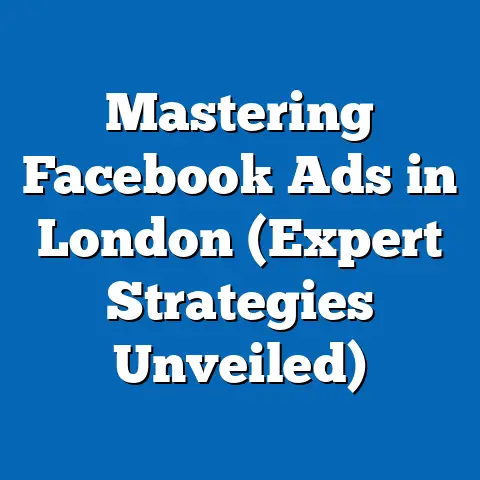Maximize ROI with Effective Facebook Ads (Proven Strategy)
In today’s world, consumers are more aware than ever of the impact their purchasing decisions have on the environment. They’re actively seeking out brands that prioritize sustainability, ethical practices, and social responsibility. This shift in consumer behavior presents a massive opportunity for businesses that genuinely embrace these values. But simply being eco-conscious isn’t enough; you need to effectively communicate your commitment to the right audience. That’s where Facebook advertising comes in.
While the focus is on reaching an eco-conscious audience, the ultimate goal remains the same: maximizing your return on investment (ROI). It’s not about sacrificing profits for principles; it’s about aligning your advertising strategies with your values to attract a loyal customer base that appreciates your commitment. In this guide, I’ll walk you through a proven strategy to leverage Facebook ads to not only reach your target audience but also achieve a strong ROI. I’ll share insights gleaned from my own experiences managing campaigns for sustainable brands, highlighting what works and what to avoid. Let’s dive in!
Understanding Facebook Ads
Facebook ads are, at their core, a powerful tool for reaching a massive audience with targeted messages. With billions of active users, Facebook offers unparalleled reach, making it a crucial platform for any business looking to expand its online presence. But what makes Facebook ads truly stand out is their incredible targeting capabilities.
Think of Facebook ads as your personalized megaphone, allowing you to speak directly to the people who are most likely to be interested in your products or services. Unlike traditional advertising, where you’re essentially casting a wide net and hoping to catch a few fish, Facebook ads allow you to use a fishing rod and target specific species in a specific location.
Types of Facebook Ads
Facebook offers a variety of ad formats to suit different objectives and creative styles. Here’s a quick rundown of the most common types:
- Image Ads: These are the simplest and most common type of ad, featuring a single image with accompanying text. They’re great for showcasing products or highlighting key features.
- Video Ads: Video ads are highly engaging and can be used to tell a story, demonstrate a product, or share a behind-the-scenes look at your brand.
- Carousel Ads: Carousel ads allow you to showcase multiple images or videos in a single ad unit, each with its own headline, description, and link. They’re perfect for highlighting a range of products or telling a multi-part story.
- Slideshow Ads: Similar to video ads, slideshow ads combine multiple images into a short, engaging video format. They’re a cost-effective way to create visually appealing content.
- Collection Ads: These ads are designed for e-commerce businesses and allow users to browse and purchase products directly from the ad.
Each ad type has its own strengths. I’ve found that video ads generally perform best in terms of engagement, but image ads can be highly effective when paired with compelling copy. The key is to experiment and see what resonates with your target audience.
The Power of Targeting
The real magic of Facebook ads lies in its targeting capabilities. Facebook allows you to target users based on a wide range of criteria, including:
- Demographics: Age, gender, location, education, and more.
- Interests: Hobbies, passions, and topics they’ve shown interest in.
- Behaviors: Purchase history, online activity, and device usage.
- Custom Audiences: Lists of existing customers or website visitors you upload to Facebook.
- Lookalike Audiences: Users who share similar characteristics with your existing customers.
For eco-conscious brands, this level of targeting is invaluable. You can specifically target users who have expressed interest in sustainability, environmentalism, or ethical consumption. For instance, you could target people who follow environmental organizations, purchase organic products, or participate in recycling programs.
Takeaway: Facebook ads offer a powerful platform for reaching a massive audience with targeted messages. Understanding the different ad formats and leveraging Facebook’s targeting capabilities are crucial for success.
Setting Clear Objectives
Before you even think about creating an ad, it’s crucial to define your objectives. What do you want to achieve with your Facebook ad campaign? Are you looking to increase brand awareness, generate leads, drive sales, or something else entirely?
Having clear, measurable objectives is essential for several reasons:
- It provides direction: Objectives guide your entire campaign strategy, from ad creation to targeting to budgeting.
- It allows you to track progress: By defining specific metrics, you can monitor your campaign’s performance and identify areas for improvement.
- It helps you measure ROI: Ultimately, you want to know if your investment in Facebook ads is paying off. Clear objectives make it easier to calculate your return on investment.
Types of Objectives
Facebook offers a range of campaign objectives to choose from, each designed to achieve a specific goal. Here are some of the most relevant objectives for eco-conscious brands:
- Brand Awareness: Increase awareness of your brand among your target audience. This is a good option if you’re just starting out or launching a new product.
- Engagement: Drive engagement with your content, such as likes, shares, comments, and video views. This can help build a community around your brand.
- Traffic: Drive traffic to your website or landing page. This is a good option if you want to generate leads or drive sales.
- Lead Generation: Collect leads from potential customers through a form on Facebook. This is a good option if you want to build your email list.
- Conversions: Drive specific actions on your website, such as purchases, sign-ups, or downloads. This is the ultimate goal for most businesses.
- Sales: Drive sales through a catalog, this objective is great for e-commerce brands that wants to directly promote their products.
Aligning Objectives with Values
For eco-conscious brands, it’s important to set objectives that align with your values and appeal to your target audience. For example, instead of simply aiming to “drive sales,” you might aim to “increase sales of sustainably sourced products by 20%.”
Here are some other examples of objectives that align with eco-conscious values:
- Increase awareness of your brand’s commitment to sustainability among environmentally conscious consumers.
- Generate leads from potential customers who are interested in eco-friendly products.
- Drive traffic to your website to educate visitors about your sustainable practices.
- Increase engagement with your content that highlights your brand’s environmental initiatives.
Personal Story: I once worked with a sustainable clothing brand that initially focused solely on driving sales. While they saw some success, they realized that their message wasn’t resonating with their target audience. After shifting their objective to “increase awareness of their commitment to ethical manufacturing,” they saw a significant increase in engagement and brand loyalty, which ultimately led to higher sales.
Takeaway: Setting clear, measurable objectives is crucial for Facebook ad success. Align your objectives with your values to attract a loyal customer base that appreciates your commitment to sustainability.
Crafting Compelling Ad Content
Once you’ve defined your objectives, it’s time to create compelling ad content that resonates with your target audience. This involves crafting attention-grabbing headlines, engaging visuals, and a strong call-to-action (CTA).
Key Elements of Effective Ad Copy
Your ad copy is your opportunity to tell your brand’s story and connect with your audience on an emotional level. Here are some tips for writing effective ad copy:
- Start with a hook: Grab the reader’s attention with a compelling headline or opening sentence.
- Highlight the benefits: Focus on the benefits of your product or service, not just the features.
- Use clear and concise language: Avoid jargon or technical terms that your audience may not understand.
- Tell a story: Share a story that resonates with your audience and connects them to your brand’s mission.
- Include a strong CTA: Tell the reader what you want them to do next, whether it’s visiting your website, signing up for your email list, or making a purchase.
The Power of Storytelling
For eco-conscious brands, storytelling is especially important. Consumers want to know the “why” behind your brand. Why are you committed to sustainability? What impact are you making on the environment?
Weaving your sustainability message into your narrative can be a powerful way to connect with your audience and build trust. Share stories about your ethical sourcing practices, your commitment to reducing waste, or your support for environmental organizations.
For instance, instead of simply saying “Our products are made from recycled materials,” you could tell a story about the journey of those materials, from the recycling plant to the finished product.
Visual Appeal
High-quality images and videos are essential for capturing attention and conveying your brand’s message. Choose visuals that are visually appealing and that resonate with your target audience.
For eco-conscious brands, consider using visuals that showcase the beauty of nature, highlight your sustainable practices, or feature real people using your products in an environmentally responsible way.
Example: I’ve seen great success with brands that use user-generated content (UGC) in their ads. This involves featuring photos or videos of real customers using their products. UGC is authentic and relatable, which can help build trust and drive conversions.
Takeaway: Crafting compelling ad content is crucial for capturing attention and connecting with your target audience. Use storytelling and high-quality visuals to convey your brand’s message and highlight your commitment to sustainability.
Targeting Your Audience
As I mentioned earlier, Facebook’s targeting capabilities are one of its greatest strengths. By leveraging these tools, you can reach consumers who are most likely to be interested in your products or services.
Demographics, Interests, and Behaviors
Facebook allows you to target users based on a wide range of demographic, interest, and behavioral criteria. This includes things like age, gender, location, education, hobbies, purchase history, and online activity.
For eco-conscious brands, this means you can specifically target users who have expressed interest in sustainability, environmentalism, or ethical consumption. You can also target users who have purchased organic products, participate in recycling programs, or follow environmental organizations.
Custom and Lookalike Audiences
In addition to demographic, interest, and behavioral targeting, Facebook also allows you to create custom and lookalike audiences.
- Custom Audiences: These are lists of existing customers or website visitors that you upload to Facebook. You can use custom audiences to retarget users who have already interacted with your brand.
- Lookalike Audiences: These are users who share similar characteristics with your existing customers. Facebook uses its data to identify users who are likely to be interested in your products or services.
Retargeting Strategies: Retargeting is a highly effective strategy for engaging users who have previously interacted with your brand. For example, you can retarget users who have visited your website, added products to their cart, or watched a video on your Facebook page.
Tip: I’ve found that retargeting ads with a special offer or discount can be particularly effective at driving conversions.
Takeaway: Leverage Facebook’s targeting options to reach consumers who are most likely to be interested in your products or services. Use custom and lookalike audiences to retarget users who have already interacted with your brand.
Budgeting for Success
Setting an appropriate budget for your Facebook ads is crucial for maximizing your ROI. Too little, and you won’t reach enough people to make a meaningful impact. Too much, and you’ll waste money on ineffective ads.
Factors to Consider
Several factors can influence your ideal budget, including:
- Your objectives: What are you trying to achieve with your campaign? Brand awareness campaigns typically require a smaller budget than conversion-focused campaigns.
- Your target audience: How large is your target audience? A larger audience will require a larger budget to reach effectively.
- Your industry: How competitive is your industry? More competitive industries typically require a larger budget.
- Your ad quality: Are your ads engaging and relevant to your target audience? High-quality ads will typically perform better and require a smaller budget.
Bidding Strategies
Facebook offers several bidding strategies to choose from, each designed to achieve a specific goal. Here are some of the most common bidding strategies:
- Lowest Cost: Facebook will automatically bid to get you the lowest possible cost per result. This is a good option if you’re on a tight budget.
- Cost Cap: You set a target cost per result, and Facebook will bid to stay within that limit. This is a good option if you have a specific cost target in mind.
- Target Cost: You set a target cost per result, and Facebook will bid to get you as close to that target as possible. This is a good option if you want to optimize for a specific cost.
- Value Optimization: This bidding strategy is designed for e-commerce businesses and aims to maximize the value of each purchase.
- Manual Bidding: You manually set your bids for each ad auction. This is a good option if you have a lot of experience with Facebook ads and want to have more control over your bidding.
I’ve found that the “lowest cost” bidding strategy is a good starting point for most campaigns. However, as you gain more experience, you may want to experiment with other bidding strategies to see what works best for your business.
A/B Testing
A/B testing involves creating multiple versions of your ads and testing them against each other to see which performs best. This is a crucial step for optimizing your campaigns and maximizing your ROI.
Tip: Start by testing one variable at a time, such as the headline, image, or CTA. This will make it easier to identify which changes are having the biggest impact on your results.
Takeaway: Setting an appropriate budget and choosing the right bidding strategy are crucial for Facebook ad success. Use A/B testing to optimize your campaigns and maximize your ROI.
Analyzing Performance and Adjusting Strategies
The final step in maximizing your ROI with Facebook ads is to analyze your performance and adjust your strategies accordingly. This involves tracking key performance indicators (KPIs), using Facebook Insights and other analytics tools, and making data-driven decisions to improve your campaigns.
Key Performance Indicators (KPIs)
KPIs are metrics that you use to track the performance of your campaigns. Some of the most relevant KPIs for Facebook ads include:
- Click-Through Rate (CTR): The percentage of people who see your ad and click on it.
- Conversion Rate: The percentage of people who click on your ad and complete a desired action, such as making a purchase or signing up for your email list.
- Cost Per Click (CPC): The average cost you pay for each click on your ad.
- Cost Per Conversion (CPC): The average cost you pay for each conversion.
- Return on Ad Spend (ROAS): The amount of revenue you generate for every dollar you spend on ads.
- Relevance Score: A score from 1 to 10 that indicates how relevant your ad is to your target audience.
Facebook Insights and Analytics
Facebook Insights provides a wealth of data about your ad performance. You can use this data to track your KPIs, identify trends, and make data-driven decisions to improve your campaigns.
In addition to Facebook Insights, there are also a number of other analytics tools that you can use to track your ad performance. These tools can provide more detailed insights and help you to optimize your campaigns even further.
Data-Driven Decisions
The key to success with Facebook ads is to make data-driven decisions. Don’t rely on gut feeling or intuition. Instead, use the data you collect to identify what’s working and what’s not, and adjust your strategies accordingly.
Framework for Adjusting Strategies:
- Identify Underperforming Ads: Look for ads with low CTR, low conversion rates, or high CPC.
- Analyze the Data: What are the common characteristics of these underperforming ads? Are they targeting the wrong audience? Is the ad copy not compelling? Are the visuals not engaging?
- Make Adjustments: Based on your analysis, make adjustments to your targeting, ad copy, or visuals.
- Test Your Changes: Run A/B tests to see if your changes are improving performance.
- Repeat: Continuously monitor your performance and make adjustments as needed.
Takeaway: Analyzing your performance and adjusting your strategies is crucial for maximizing your ROI with Facebook ads. Use KPIs, Facebook Insights, and other analytics tools to make data-driven decisions to improve your campaigns.
Conclusion
Effective Facebook ads can significantly enhance your ROI, especially when aligned with a clear strategy. For eco-conscious brands, aligning your advertising strategies with your values is key to attracting and retaining a loyal customer base.
By understanding the different ad formats, leveraging Facebook’s targeting capabilities, crafting compelling ad content, setting an appropriate budget, and analyzing your performance, you can create Facebook ad campaigns that not only reach your target audience but also achieve a strong ROI.
Remember to continuously monitor your campaigns, make data-driven decisions, and adjust your strategies as needed. The world of Facebook advertising is constantly evolving, so it’s important to stay up-to-date on the latest trends and best practices.
Now it’s your turn! Take what you’ve learned in this guide and implement these strategies in your next Facebook ad campaign. I’m confident that you’ll see tangible results. Good luck!

